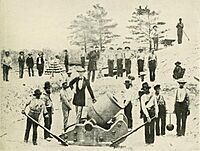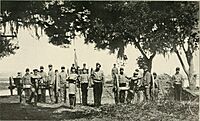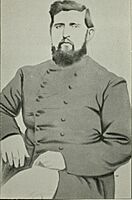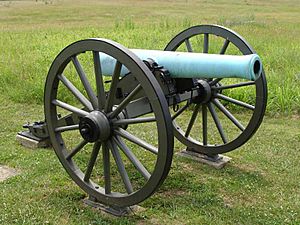Confederate States Army facts for kids
Quick facts for kids Confederate States Army |
|
|---|---|
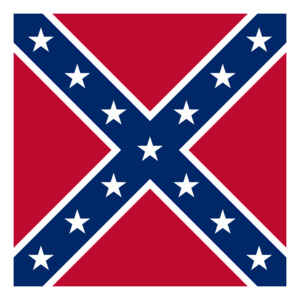
Battle flag of the Army of Northern Virginia
|
|
| Founded | February 28, 1861 |
| Country | |
| Type | Army |
| Size | 1,082,119 total who served
|
| Part of | |
| Colors | Cadet Gray |
| March | "Dixie" |
| Conflicts | |
| Disbanded | May 26, 1865 |
| Commanders | |
| Commander in Chief | Jefferson Davis (1861–65) |
| General in Chief | General Robert E. Lee (1865) |
The Confederate States Army (CSA) was the army of the Confederate States of America. This new country was formed in February 1861, just before the American Civil War began. The army was created to protect the Confederate states. About 750,000 to 1.2 million soldiers fought for the Confederacy. We don't know the exact number because many records were lost or destroyed.
Even though the Confederate Army won many battles, it could not win the war. The Union Army had more soldiers and better supplies. On April 9, 1865, General Robert E. Lee gave up his army, the Army of Northern Virginia, to General Ulysses S. Grant. This happened at Appomattox Court House, Virginia. Lee's surrender was a major turning point, marking the end of the Confederacy. The very last Confederate general to surrender was Stand Watie on June 23, 1865.
Contents
How the Confederate Army Was Set Up
The Confederate States Army was much like the U.S. Army. Both armies had soldiers who fought on foot (infantry), on horses (cavalry), and with cannons (artillery). Many Confederate officers had gone to West Point, just like Union officers.
Soldier groups called regiments were usually numbered. They were also named after the state where the soldiers came from. For example, a regiment might be called the "1st Virginia Infantry." Larger groups called brigades were often named after their leaders. The Stonewall Brigade was named after its commander, Stonewall Jackson.
The Confederate Army had three main parts:
- The Army of the Confederate States of America (ACSA): This was the smallest part. It was meant to be the regular, permanent army.
- The Provisional Army of the Confederate States (PACS): This was the "volunteer" army. It was supposed to be ended after the war.
- State militias: These were local groups of soldiers from each Southern state.
The Confederate Constitution said that the President, Jefferson Davis, was the main commander of the army and navy. There wasn't one single commanding general for the whole army until late in the war. Instead, several generals advised President Davis.
Army Structure and Units
The Confederate Army was organized into different-sized groups:
- A regiment was the main fighting unit. At the start of the war, a regiment had about 1,000 men. It was led by a colonel. Soldiers in a regiment often came from the same area and knew each other. Over time, regiments lost many men due to fighting, sickness, or soldiers leaving. Instead of adding new recruits to a small regiment, a new regiment was often started.
- A brigade had two to five regiments. It was led by a brigadier general. Brigades usually had soldiers from only one type of fighting unit, like all infantry or all cavalry.
- A division had two or more brigades. In the Confederate army, a division could have up to five or six brigades. A major general commanded a division.
- A corps had two or more divisions. A corps usually had infantry, cavalry, and artillery. This made a corps able to fight on its own.
- An army was made of two or more corps. The most experienced major general or a general chosen by Jefferson Davis usually led a corps or an army.
Main Confederate Armies
The Confederate States Army had several important armies:
- The Army of Northern Virginia was the main Confederate force in the eastern part of the war.
- The Confederate Army of the Shenandoah later joined the Confederate Army of the Potomac after the First Battle of Bull Run.
- The Army of the Peninsula was formed in May 1861 and later became part of the Army of Northern Virginia.
- The Confederate Army of the Northwest was an early army that was later ended.
- The Army of Central Kentucky was created in 1861. It later became part of the Army of Mississippi, which then became the Army of Tennessee.
- The Army of New Mexico was a smaller army that fought in the New Mexico Territory.
- The Army of the West was mostly made up of the Missouri State Guard.
Confederate Officers
Before the Civil War, many Confederate officers had served in the United States Army. When the war started, 313 U.S. Army officers quit to join the Confederate army. Robert E. Lee was one of them. He was offered command of the Union Army by Abraham Lincoln. But Lee felt he could not fight against his home state of Virginia. So, he joined the Virginia militia, which then became part of the Confederate army.
Many local militias chose their own officers. When these groups joined the Confederate army, their officers were given official ranks. Some professional officers also came from Germany or Britain. At the start of the war, few Southern officers had much real experience. Some wealthy landowners were not required to serve in the army. Some officers had personal servants with them during the war.
Confederate Soldiers
Confederate officers sometimes struggled to keep their soldiers in strict order. Many soldiers could not read or write. Some even had trouble telling their left foot from their right. At the Battle of Gettysburg in 1863, even General Lee noted the lack of strict discipline in his army. Visitors from other countries were surprised that these soldiers could fight so well despite their relaxed discipline.
Most Confederate soldiers had ancestors from Scotland, England, Ireland, and Wales. Some also had roots in France and Southern Europe. In some groups, like the 33rd Texas Cavalry, many soldiers had Spanish ancestors. In the Deep South, the Cherokee Nation sent several regiments that fought alongside other Confederate units.
The average Confederate soldier was in his early 20s. He often looked thin and messy, and beards were common. His wool uniform was often torn and worn out. It often didn't fit well, especially if it was taken from a dead soldier. Most wore a white shirt under their wool jacket. Getting new uniforms was hard. Soldiers often dyed homemade clothes with a dye made from walnuts. This gave their uniforms a yellowish-brown color they called "butternut." Many soldiers did not have shoes, or their shoes didn't fit. Those who did sometimes nailed horseshoes to the bottom to make them last longer.
At first, soldiers carried old muskets or flintlock rifles. Later in the war, many used better Enfield rifles taken from dead Union soldiers. What the Confederate soldier lacked in supplies, he made up for with his fighting spirit. Any boots, uniforms, or supplies left behind by Union soldiers or captured were used by the Confederates. Many tents in Confederate camps were marked "U.S." Most of the Southern cannons were also captured Union cannons.
Army Size and Recruitment
It's hard to know the exact number of soldiers who served in the Confederate army. This is because many records were destroyed in 1865. Experts guess that between 750,000 and 1,000,000 individual soldiers fought at some point during the war. These numbers show how many different people served, not how many were in the army at one time.
The Confederate government asked for soldiers several times:
- March 6, 1861: 100,000 volunteers and militia.
- January 23, 1862: 400,000 volunteers and militia.
- April 16, 1862: The First Conscription Act made it law for white men aged 18 to 35 to join the army for the whole war.
- September 27, 1862: The Second Conscription Act changed the age range to 18 to 45.
- February 17, 1864: The Third Conscription Act expanded the age range even more, from 17 to 50.
- March 13, 1865: A law was passed to allow up to 300,000 African American slaves to serve as troops, but this was never fully put into action.
The Confederate Army was mostly meant to defend its own land. Many soldiers were not happy when General Robert E. Lee led his Army of Northern Virginia into the North in September 1862. This was during the Antietam campaign in Maryland.
Army Leadership
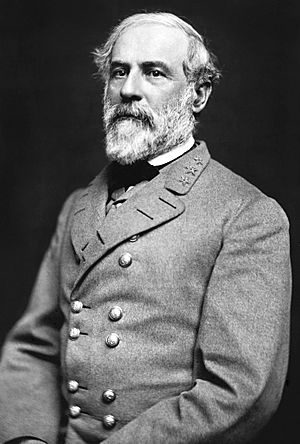
The Confederate States Army did not have one main military commander, or "general in chief," until late in the war. The Confederate President, Jefferson Davis, was the main commander. He had been a U.S. Army officer and U.S. Secretary of War before. He guided the overall plans for the Confederate land and naval forces.
Some leaders had a lot of control:
- Robert E. Lee was in charge of military operations from March to May 1862. He advised President Davis and had a lot of control over the army's plans and supplies. On June 1, he took command of the Army of Northern Virginia, which was seen as the most important Confederate army.
- Braxton Bragg also advised President Davis on military operations from February 1864 to January 1865.
- Lee was officially named General in Chief of the Armies of the Confederate States by Congress in January 1865. He served in this role until April 1865.
Not having one central leader was a weakness for the Confederacy. Their armies rarely worked together across different areas to reach a common goal. For example, in late 1862, Lee invaded Maryland at the same time as other Confederate armies invaded Kentucky and attacked Corinth, Mississippi. All three attacks failed. Some state governors, like Joseph E. Brown of Georgia, even tried to stop Confederate soldiers from leaving their state to fight elsewhere.
Many top Confederate military leaders, including Robert E. Lee and President Jefferson Davis, had been U.S. Army officers. They were not always in favor of states leaving the Union. But they quit their U.S. jobs when their home states left. They felt they had to help defend their homes. President Abraham Lincoln was frustrated by these men who said they loved their country but were willing to fight against it.
Ranks and Badges
| Officer rank structure of the Confederate Army | ||||||||||
|---|---|---|---|---|---|---|---|---|---|---|
| General | Colonel | Lieutenant colonel | Major | Captain | First lieutenant | Second lieutenant | ||||
 |
||||||||||
There were four levels of general officers: general, lieutenant general, major general, and brigadier general. But all generals wore the same badge. Robert E. Lee was an exception; he chose to wear the badge of a colonel. Only seven men reached the highest rank of full general.
Officers' uniforms had braided designs on the sleeves and hats (called kepis). The number of braids showed their rank. The color of the braids and kepi showed their military branch. Officers sometimes removed the braids because they made them easy targets for enemy soldiers. The kepi hat was not often used; soldiers preferred a slouch hat because it was more practical in the Southern weather.
| Enlisted rank structure | ||||||||||
|---|---|---|---|---|---|---|---|---|---|---|
| Sergeant Major | Quartermaster Sergeant | Ordnance Sergeant | First Sergeant | |||||||
 |
 |
 |
 |
|||||||
| Sergeant | Corporal | Musician | Private | |||||||
 |
 |
no insignia | no insignia | |||||||
The color of the chevrons (V-shaped badges) on uniforms showed the branch: blue for infantry, yellow for cavalry, and red for artillery. However, this could change depending on what supplies were available or what the unit commander wanted.
The Confederate Army was different because soldiers elected all officers below the rank of brigadier general. In 1862, Congress allowed medals for bravery. But it was hard to get the medals during the war. So, brave soldiers had their names put on a "Roll of Honor." Their names would be read aloud, and published in newspapers.
Supplies and Logistics
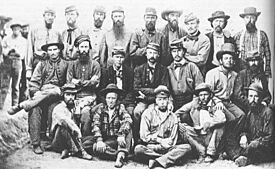
Getting supplies for most Confederate armies was very difficult. The central Confederate government did not have much money. Each state government was supposed to supply its own regiments. This lack of central control, along with poor railroads, made it hard to get supplies. Also, Southern states often couldn't or wouldn't provide enough money.
The Confederacy lost control of most of its major rivers and ocean ports early in the war. The U.S. Navy also set up a blockade, stopping ships from bringing supplies. Roads were bad, so the army relied more and more on the railroads. Union forces often destroyed train tracks, engines, bridges, and telegraph lines. They knew the Confederacy couldn't easily replace them.
Because of these supply problems, Confederate soldiers rarely had standard uniforms, especially as the war went on. Soldiers often wore a mix of faded, patched-up uniforms, rough homemade clothes dyed with "butternut" (a yellowish-brown color), or even civilian clothes. After winning a battle, Confederate troops would often take parts of U.S. Army uniforms from captured supplies or dead soldiers. This sometimes caused confusion in later fights.
Each state was expected to supply its own soldiers, which meant uniforms were not always the same. Some states, like North Carolina, were better at supplying their soldiers than others, like Texas. Confederate soldiers also often lacked shoes, tents, and other gear. They had to be clever and use whatever they could find in the countryside. While officers usually had better uniforms, they often shared other hardships, like not having enough food, with their troops.

Confederate soldiers also faced a lack of food, especially as the war continued. There was meat in the Confederacy, but the problem was getting it to the armies. This was especially true for Lee's army in Virginia, which was at the end of a very long supply line. When the United States won at Vicksburg in 1863, it cut off supplies from Texas and the west.
By 1863, Confederate generals like Robert E. Lee spent as much time trying to find food for their men as they did planning battles. Commanders often had to "beg, borrow, or steal" food and ammunition from anywhere they could. This included captured U.S. supply depots and private citizens. Lee's campaign into Pennsylvania (a rich farming area) before the Battle of Gettysburg was partly because he desperately needed supplies, especially food.
General Sherman's "total warfare" tactics made it harder for the South to produce food and send it to the armies or cities. Along with the U.S. blockade of all ports, the destruction of farms and railroads meant the Confederacy struggled more and more to feed its soldiers and people.
Army Numbers
Because many records were destroyed, it's hard to know the exact number of soldiers who served in the Confederate army. Historians estimate that between 750,000 and 1,000,000 individual Confederate soldiers served.
The number of Confederate soldiers who died is also hard to know for sure. The best estimates are about 94,000 killed or badly wounded in battle. About 164,000 died from diseases. Between 26,000 and 31,000 died in Union prison camps.
Compared to the Union Army, the Confederate Army was not very diverse. About 91% of Confederate soldiers were white men born in the South. Only 9% were white men born in other countries. The largest group of foreign-born soldiers were Irishmen. There were also Germans, French, Mexicans, and British. A small number of Asian men were forced to join the Confederate Army when they arrived in Louisiana.
Images for kids
-
Private Edwin Francis Jemison, whose image became one of the most famous portraits of the young soldiers of the war
-
A painting of Lee's Army of Northern Virginia fighting the U.S. Army at Spotsylvania in 1864
-
Jackson McCurtain, Lieutenant Colonel of the First Choctaw Battalion in Oklahoma, CSA
-
1862 illustration showing Confederates escorting kidnapped African American civilians south into slavery. A similar instance occurred in Pennsylvania when the Army of Northern Virginia invaded it in 1863 to fight the U.S. at Gettysburg.
-
An 1862 illustration of a Confederate officer forcing slaves at gunpoint to fire a cannon at U.S. soldiers in battle. A similar instance occurred at the first Battle of Bull Run, where slaves were forced by the Confederates to load and fire a cannon at U.S. forces.
See also
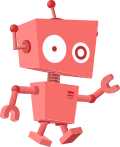 In Spanish: Ejército de los Estados Confederados para niños
In Spanish: Ejército de los Estados Confederados para niños




